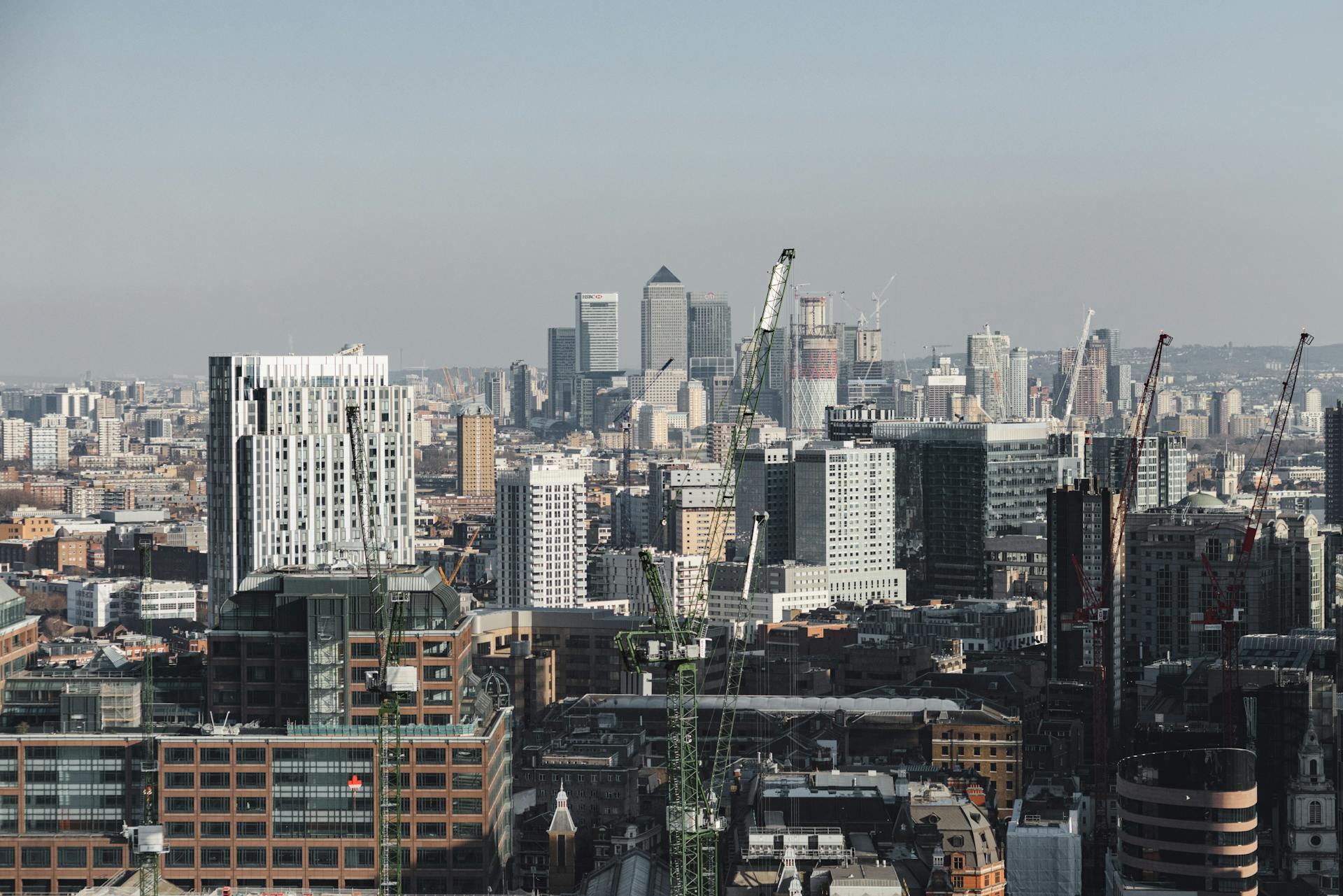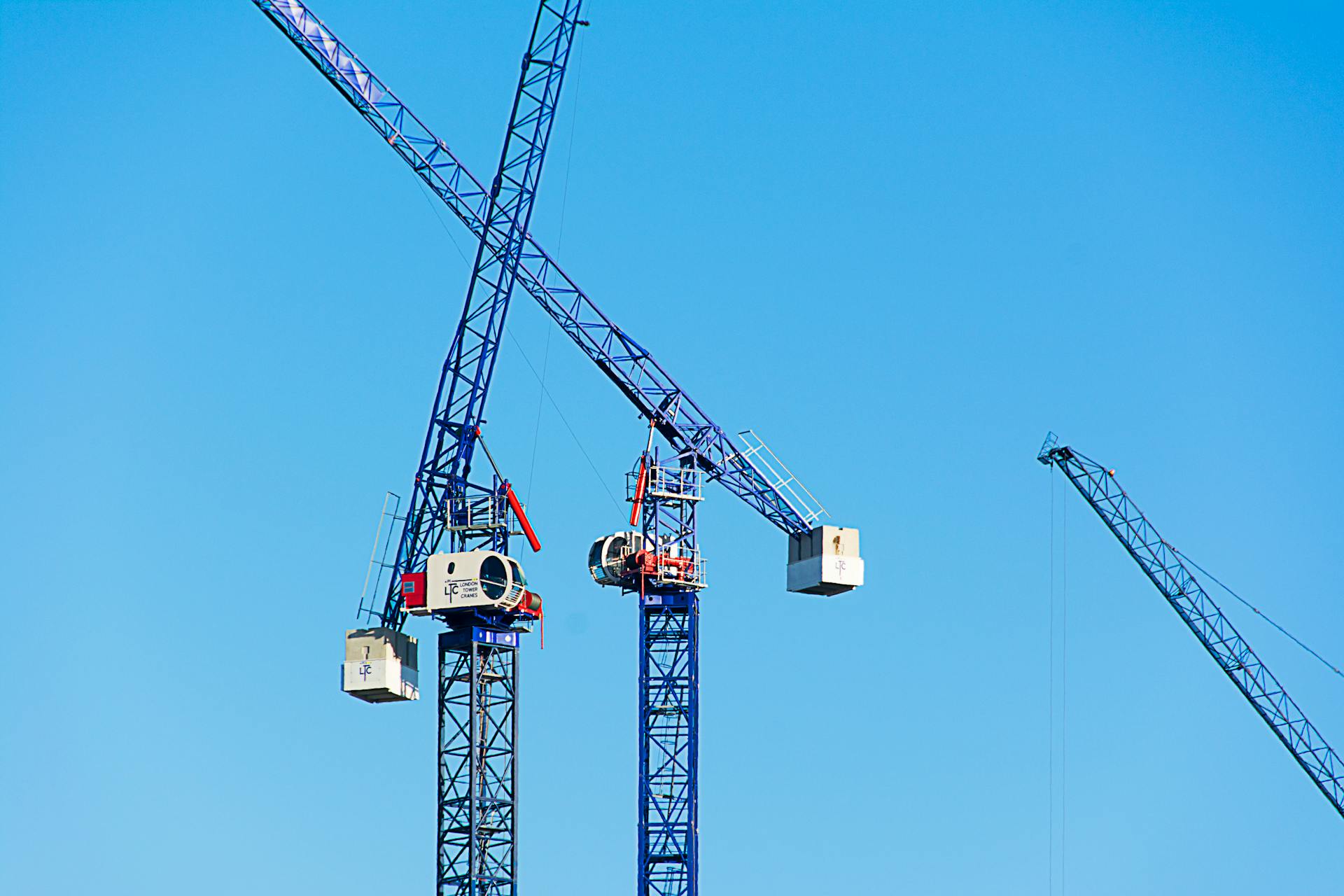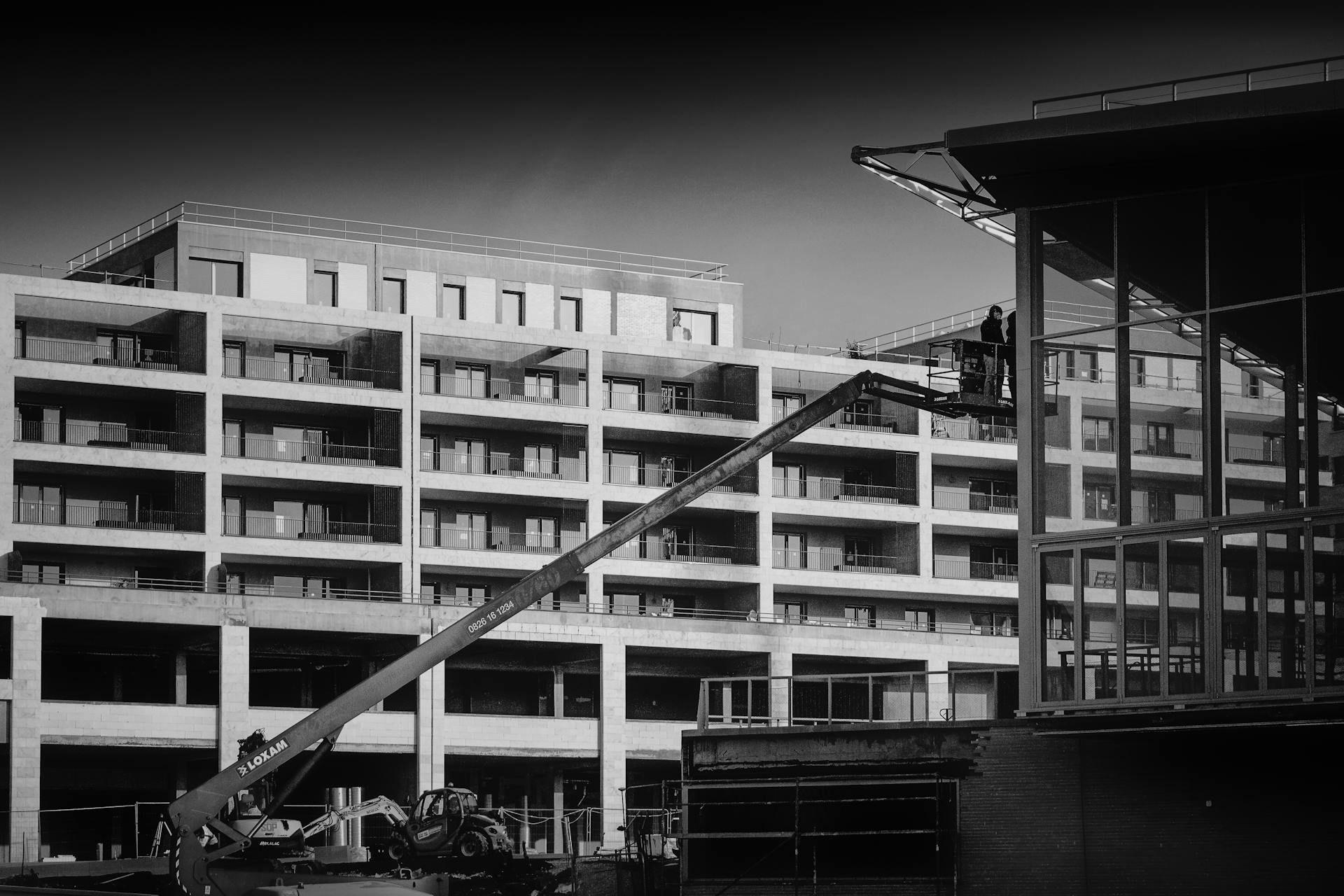
A jib crane installation can be a game-changer for your workspace, but it's essential to do it right to ensure safety and efficiency.
First, identify the load capacity of your crane, which is typically determined by the weight of the heaviest object you plan to lift.
To calculate the load capacity, consider the weight of the crane itself, the weight of the load, and any additional factors such as wind or seismic loads.
A well-planned installation will also involve determining the crane's span and height, taking into account the available space and any obstacles in the area.
Design and Installation
To ensure a safe and efficient jib crane installation, it's crucial to pay attention to a few key details. Proper installation is essential to avoid accidents and construction delays.
The strength of the concrete is critical when installing a cantilever crane. Don't start installation if the concrete is not fully set, as it may compromise the load-bearing capacity of the crane.
A flat and debris-free floor is also essential for a stable installation. If the floor is paved with tiles, add a suitable layer of cloth to increase friction with the ground.
Foundationless
Foundationless jib cranes are a great option for facilities where speed and flexibility are key. They can be installed almost anywhere as long as the area meets the manufacturer's requirements.
These cranes are slab-mounted and bolted to 6" reinforced concrete, eliminating the need for a special poured foundation. This means installation can be done faster, with no waiting for concrete to cure.
Typically, foundationless jib cranes can accommodate a range of specifications. Here are some of the key details:
- Spans of 9-16' are common
- Capacities up to 1,000 lbs. are possible
- 360° rotation is standard
- Boom heights up to 20' are achievable
While they may have a lower capacity than traditional freestanding jib cranes, foundationless jibs offer a cost-effective and portable solution for many applications.
Wall Bracket
When designing a wall bracket for a jib crane, it's essential to consider the specifications of the crane. Wall bracket jib cranes are versatile and can be used in various settings, including bays, along walls or columns, and as supplements to an overhead crane or monorail system.
They're perfect for workspaces where headroom is at a premium. These jibs utilize I-beam boom assemblies for heavier capacities and longer spans.
Broaden your view: Wall Bracket Jib Crane
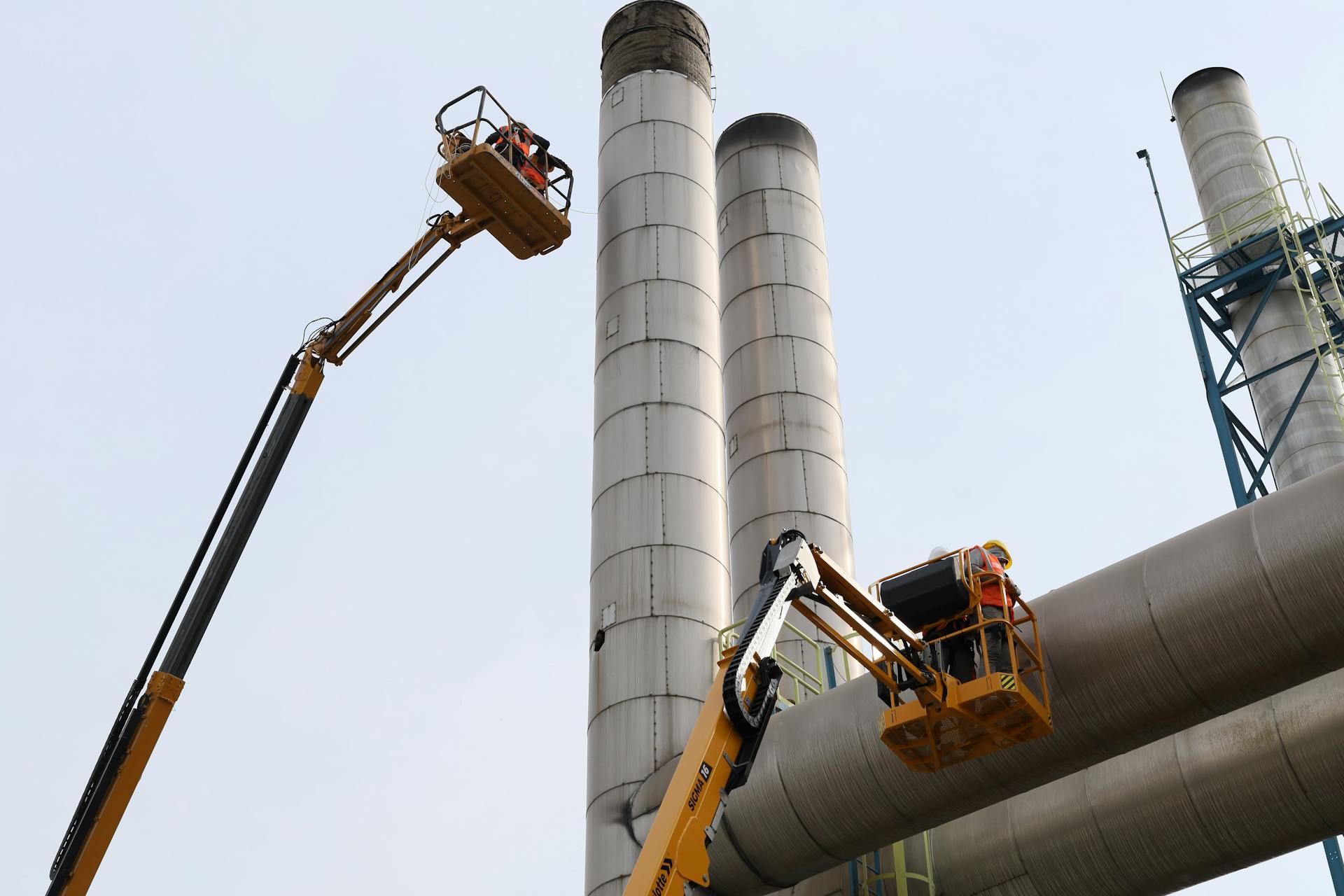
The standard lifting capacity of wall bracket jib cranes is 0.25 to 5 tons. This range provides flexibility for different applications and load requirements.
Wall bracket jib cranes can cover spans up to 30 feet, making them suitable for a variety of tasks and workspaces.
Here are the key specifications for wall bracket jib cranes:
Precautions and Planning
Installing a jib crane requires careful planning and attention to detail to ensure a safe and efficient operation. Ensure the performance and quality of the cantilever crane before starting installation.
Don't rush the installation process to shorten the construction period, as this can lead to weak concrete and accidents. Improper installation can cause the load-bearing capacity of the cantilever crane to exceed the ground stress, resulting in collapse or overturning.
A flat and debris-free floor is essential for a stable installation. If the floor is paved with tiles, add a suitable layer of cloth to increase friction with the ground.
Worth a look: Cantilever Jib Crane
Precautions for Installation
Pillar jib cranes are a convenient and efficient option for short-distance lifting operations, but their installation requires careful attention to detail.
Ensure the strength of the concrete is high before installing the cantilever crane, as weak concrete can lead to accidents such as collapse and overturning.
A flat and debris-free floor is essential for proper installation, and if the floor is paved with tiles, a suitable layer of cloth must be added to increase friction with the ground.
Check the verticality of the column from different directions to ensure it's installed correctly.
Don't use a common hook wrench to tighten the nut fixing the screw cylinder, as it may not be strong enough - instead, use a round pipe extension for added leverage.
Always check if the nut is loose during lifting to avoid accidents.
The rotating arm on the column should be placed at an appropriate height to maintain the load-bearing capacity of the column, ideally within an angle of 45 degrees between the inclined arm and the column.
Intriguing read: Heavy Construction Equipment Accidents
Before Buying
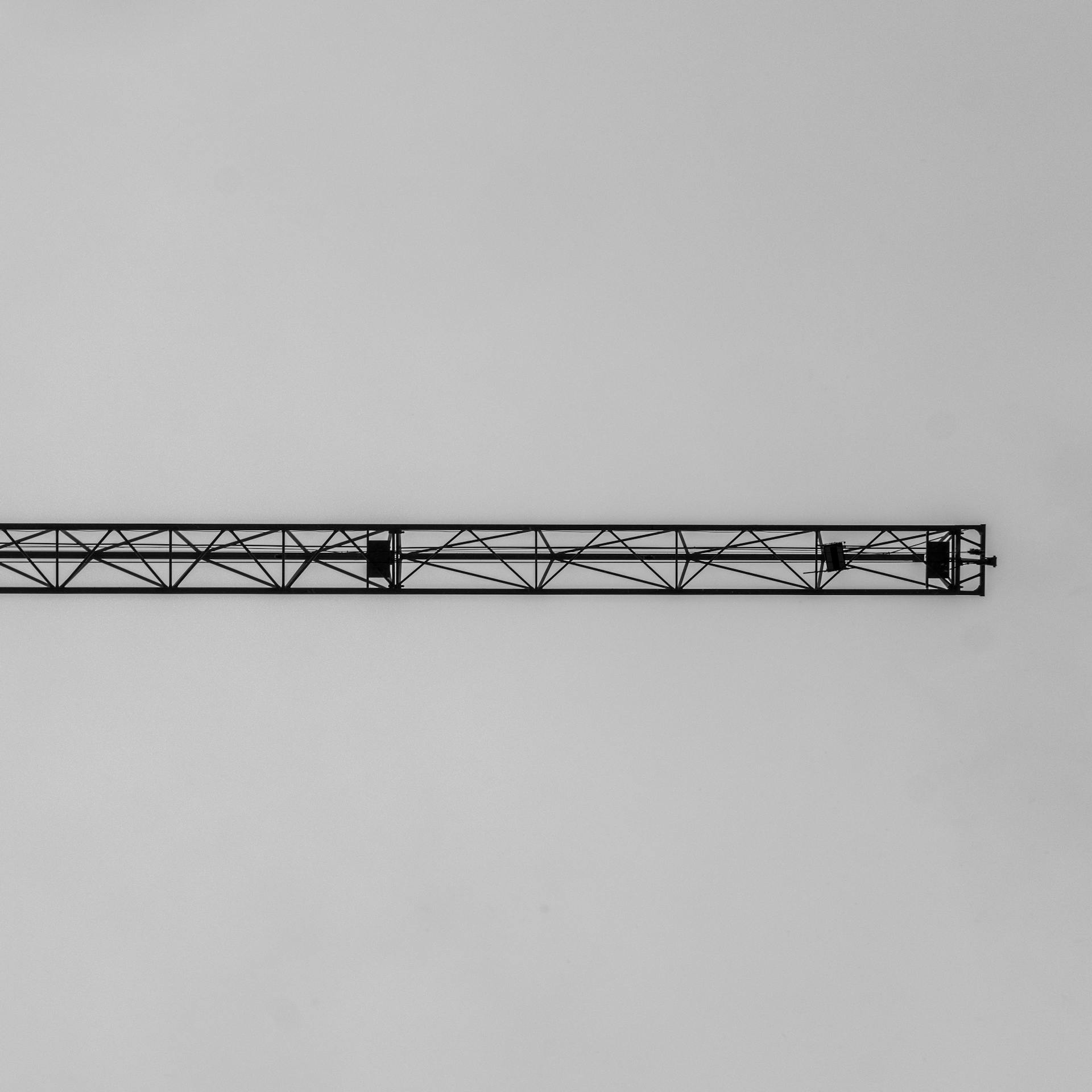
Before buying a jib crane, it's essential to consider the specific purposes it will fulfill and the lifting requirements of your workspace. The exact limitations of your workspace will determine what kind of jib crane you need to use.
The dimensions and weight of the load you require moving will impact what type of jib crane is most suited to your work area. You'll need to know the maximum load weight to make an informed decision.
Here are the maximum load weights for different types of jib cranes:
The available space in the work area is also crucial to consider, as you'll need to allow for free rotation of the boom. The approximate span of each jib crane is:
- Free-standing jib crane – up to 20’
- Mast-type jib crane – 10-20’
- Wall-mounted jib crane – 8-20’
Understanding these limitations will help you choose the right jib crane for your specific needs and ensure a safe and efficient operation.
Where Do You Need to Move It?
When you're deciding where to move it, consider the type of load and the space it needs to reach. All jib cranes can rotate up to 360 degrees, making them ideal for maneuvering loads around corners or between workstations.
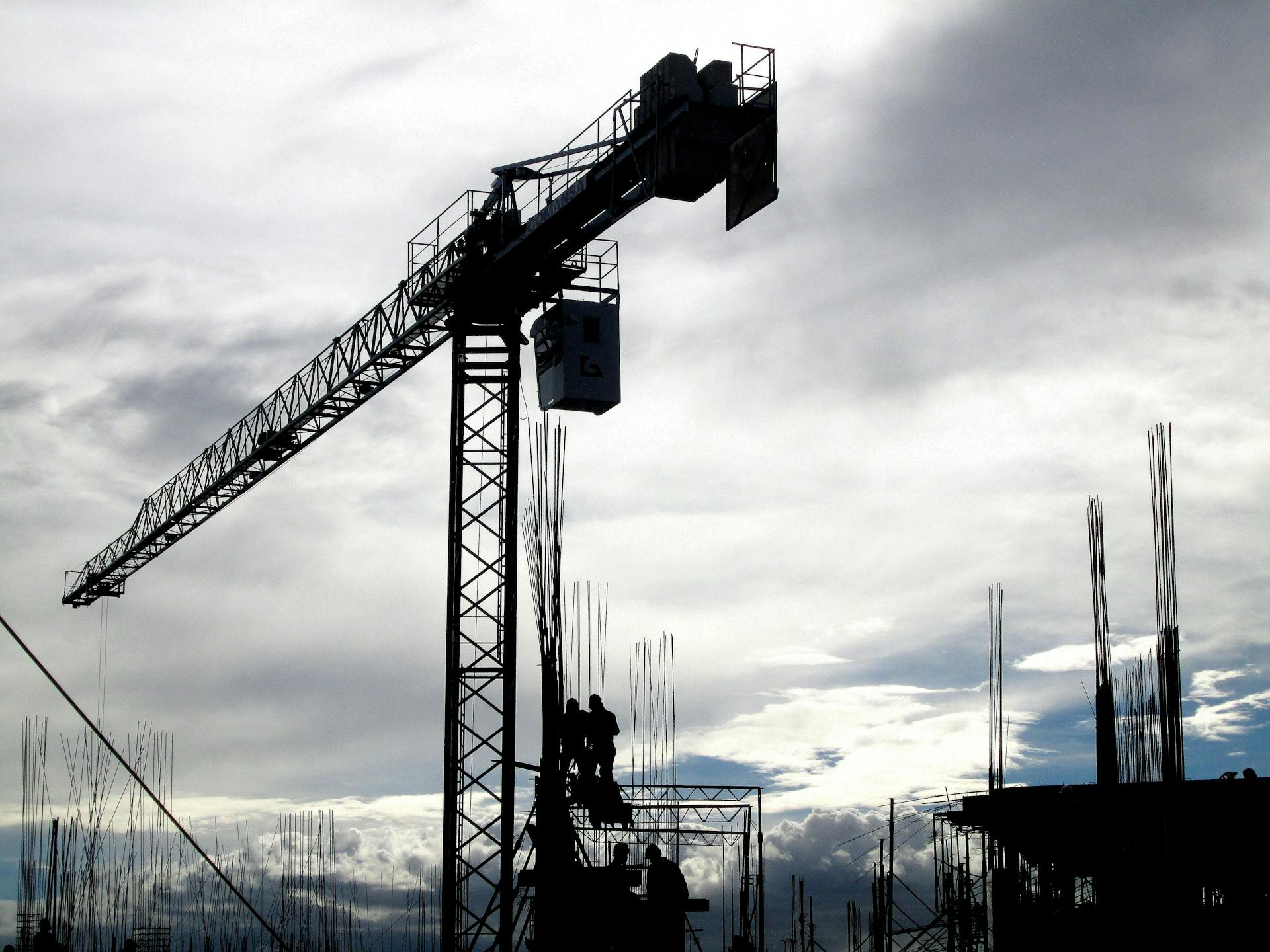
If you need to move the load in a tight space, a wall-mounted jib crane might be too limited, rotating between 180 and 200 degrees. Articulated jib cranes are a better choice for maximum maneuvering capacity.
Articulating jib systems can be mounted in various ways, including to the floor, wall, ceiling, or a bridge or track system. This flexibility provides more precise load positioning in tight spaces.
The boom span of an articulating jib system is limited to a total of 16 feet, so keep that in mind when planning your move.
Readers also liked: Jib Crane Wall Mounted
Ergonomic Workplace
Creating an ergonomic workplace is crucial for the health and productivity of your employees. Implementing a jib crane can provide a safe and better solution for repetitive and stationary lifting.
Jib cranes can be a cost-efficient solution for lifting and moving material within a limited space. They offer a complete range of motion, taking up minimal space within your facility.
A wide selection of standard jib cranes are available, and they can be modified to customer requests. This means you can always find the best solution for your operational needs.
Articulating jib arms offer a great range of motion, while portable jibs can be moved around your facility to be used wherever you need them.
Cost
When considering a jib crane, it's essential to think about the cost. A jib crane can cost anywhere from $2,000 to $30,000, depending on your specific requirements.
The cost will increase with the weight capacity you need. You could be looking at a higher price tag if you require a free-standing jib crane system, which will also require additional foundations.
Foundations can add a significant cost, both in terms of surveying and installation.
System Types and Options
Mast type jib cranes are a cost-effective alternative to freestanding systems because they don't require a special foundation. They only need 6” of reinforced concrete to support the crane.
Mast type jib cranes can accommodate a range of spans, from 10-40 feet, and capacities up to 10 tons. They also offer 360° rotation and boom heights up to 40 feet.
There are two types of cantilever design options available for mast type jib cranes:
- Full Cantilever: These can be used when there are no overhead obstructions, providing maximum lifting capability and clearance underneath.
- Drop Cantilever: Side-plate connections allow the boom to be “drop mounted” at a specific height to allow for clearance for overhead obstructions located below the top of the mast.
System Types
There are several types of jib crane systems available, each with its own set of capabilities and design options.
Mast type jib cranes are a cost-effective alternative to freestanding systems and only require 6” of reinforced concrete to support the crane.
They can accommodate spans of 10-40 feet, capacities up to 10 tons, and 360° rotation.
Boom heights can reach up to 40 feet, measured from the floor to the overhead top support.
There are two types of cantilever design options, depending on the presence of overhead obstructions.
These include a Full Cantilever, which is ideal for areas with no overhead obstructions, and a Drop Cantilever, which allows for clearance below the top of the mast.
Recommended read: Jib Crane Design Drawings
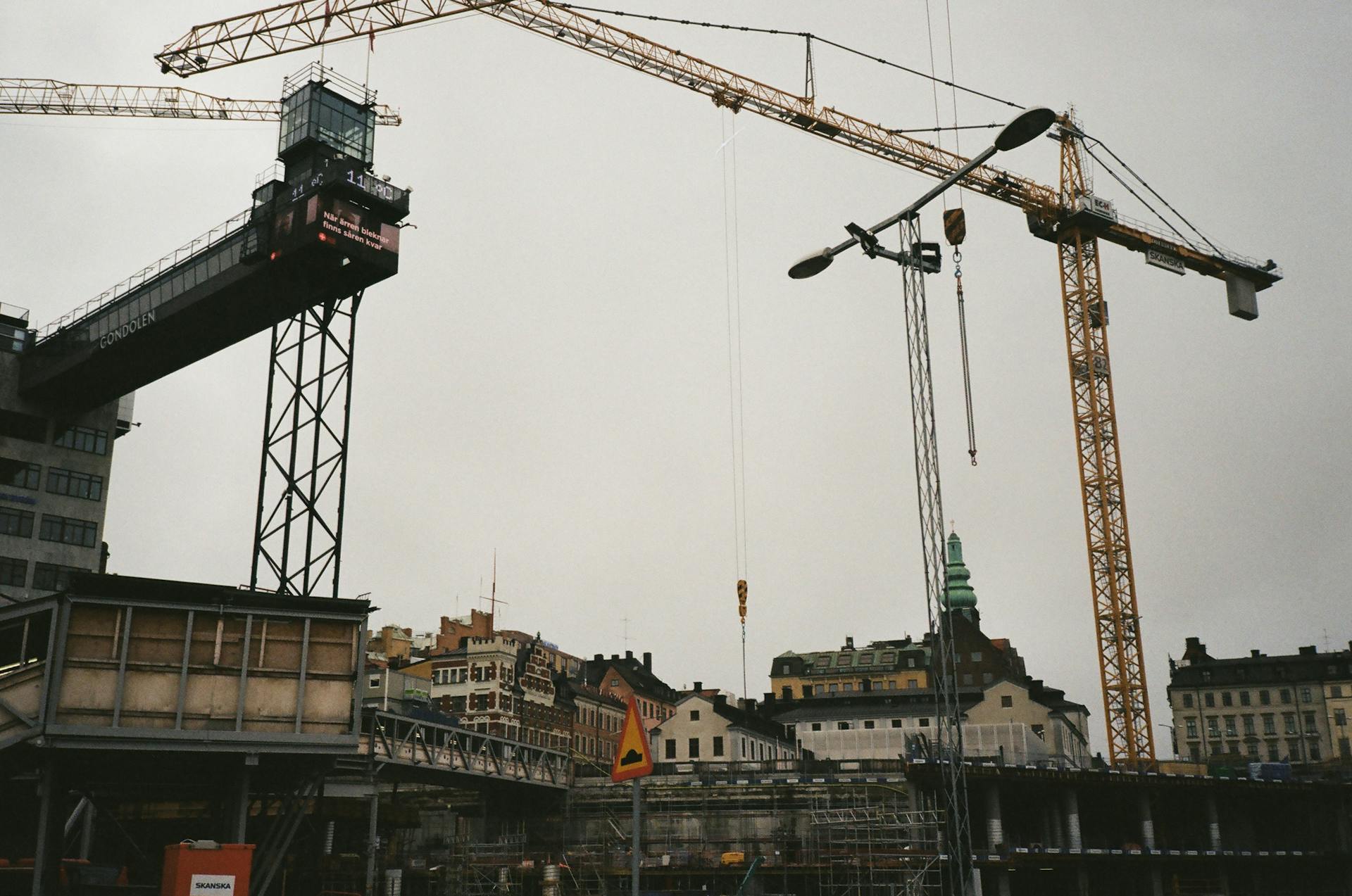
Mast type jib cranes are suitable for heavy-duty and high-productivity applications, but they do require an overhead beam or support structure for additional support.
Here's a summary of the key features of mast type jib cranes:
- Spans: 10-40 feet
- Capacities: up to 10 tons
- Rotation: 360°
- Boom heights: up to 40 feet
- Cantilever options: Full Cantilever and Drop Cantilever
Articulating
Articulating systems offer a lot of flexibility and precision when it comes to load positioning. They can swivel around corners and columns, and even reach into or under machinery and containers.
Articulating jib cranes have two swivel arms, allowing for a 200° swivel and up to 360° of rotation. This provides a greater coverage area and more flexibility closer to the mast or column.
One of the benefits of articulating jib cranes is their ability to accommodate a variety of configurations, including floor-mounted, wall-mounted, ceiling-mounted, and mounted on a bridge or track system. This allows for precise load positioning and spotting loads around obstructions.
Articulating jib cranes can handle spans up to 16 feet and capacities up to 1 ton. They're also available with optional 360° rotation at both pivot points.
Discover more: Truck Hitch Mounted Crane
Here are some key specifications for articulating jib cranes:
- Spans up to 16 feet
- Capacities up to 1 ton
- 360° rotation for freestanding and ceiling-mounted systems
- 180° inner arm/360° outer arm for wall-mounted systems
Keep in mind that articulating jib cranes may not be the best choice for heavier duty and more frequent lifts, as their design limits their capacity and span.
Mast-Type
Mast-type jib cranes are a cost-effective alternative to freestanding systems, requiring only 6” of reinforced concrete to support the crane. They can accommodate spans of 10-40’ and capacities up to 10 tons.
These cranes offer 360° rotation and can reach boom heights of up to 40’ from the floor to the overhead top support. They're similar to freestanding systems and can be used for heavy-duty and high-productivity applications.
Mast-type jib cranes require an overhead beam or support structure to provide additional support in addition to the foundation. This is a key difference between them and freestanding systems.
There are two types of cantilever design options available: full cantilever and drop cantilever. Full cantilever designs are ideal for workspaces with no overhead obstructions, while drop cantilever designs provide clearance for obstructions located below the top of the mast.
Here are some key specifications for mast-type jib cranes:
- 10-40’ spans
- Capacities up to 10 tons
- 360° rotation
- Boom heights up to 40’
Some mast-type jib cranes are available with standard 0.25 to 5 ton lifting capacity, heights up to 20 feet, and spans up to 20 feet.
What Type of Hoist
Manual and electric chain hoists are commonly used on jib cranes. They're great for most applications because they're versatile and reliable.
On some high-capacity jib cranes, wire rope hoists are a better choice due to their speed capabilities. This makes them ideal for tasks that require a lot of lifting in a short amount of time.
If you're working with a jib crane, it's essential to choose a hoist that fits your specific needs. Whether you go with a chain or wire rope hoist, make sure it's designed for the weight and capacity of your crane.
Frequently Asked Questions
How thick is the concrete for a jib crane?
For a jib crane installation, the existing concrete must be at least 6 inches thick.
What are the foundation requirements for a jib crane?
Jib crane foundations require a soil pressure of 2500 lbs. per square foot, with a recommended concrete compressive force of 3000 lbs. per square inch
Featured Images: pexels.com
